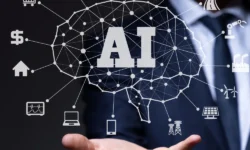📑 Table of Contents
🚀 Introduction: Building Trust in AI
As Artificial Intelligence (AI) rapidly integrates into every facet of our lives, from healthcare to finance and social media, the focus shifts beyond mere technological capability to its ethical implications. Building ethical AI solutions is no longer an option but a necessity. This involves directly confronting critical challenges such as AI bias, protecting user AI privacy, and ensuring robust AI accountability. Without a strong ethical foundation, AI risks eroding trust, perpetuating harm, and ultimately failing to achieve its transformative potential. Organizations and developers must actively embed ethical principles throughout the entire AI lifecycle.
Visualizing the harmony between technology and ethics
The delicate balance required for ethical AI development
⚖️ Understanding and Mitigating AI Bias
AI bias occurs when an AI system produces results that are systematically unfair or discriminatory. This bias often stems from the data used to train the models, which can reflect historical prejudices or underrepresentation. For example, biased training data can lead to facial recognition systems misidentifying certain demographics or loan approval algorithms unfairly rejecting minority applicants.
🎯 Key strategies to mitigate AI bias include:
- Diverse Data Collection: Actively seek out and incorporate diverse, representative datasets.
- Bias Detection Tools: Employ algorithms and techniques to identify and measure bias in models.
- Fairness Metrics: Define and apply fairness metrics during model development and evaluation.
- Human Oversight: Maintain human-in-the-loop processes, especially for high-stakes decisions.
- Transparency and Explainability: Make AI decisions interpretable to identify and correct potential biases.
🔒 Safeguarding Privacy in AI Solutions
AI privacy is a critical concern, as AI systems often rely on vast amounts of personal data. The collection, processing, and storage of this data raise questions about consent, data security, and potential misuse. High-profile data breaches and the increasing sophistication of AI for profiling individuals make privacy protection paramount. Regulations like GDPR and CCPA are setting global standards, but proactive measures are essential.
🛡️ Measures to enhance AI privacy:
- Privacy-Preserving Technologies (PPTs): Implement techniques like differential privacy, federated learning, and homomorphic encryption to protect data during analysis.
- Data Minimization: Only collect and process data that is absolutely necessary for the AI’s function.
- Anonymization and Pseudonymization: Remove or obscure identifiable information from datasets.
- Strict Access Controls: Limit who can access sensitive AI training and inference data.
- User Consent Management: Ensure transparent and explicit consent mechanisms for data usage.
👥 Establishing Accountability in AI Systems
AI accountability refers to the ability to attribute responsibility for the actions and outcomes of AI systems, especially when things go wrong. Given the complexity and autonomy of some AI, determining who is at fault—the developer, the deployer, the data provider—can be challenging. Clear frameworks are needed to ensure transparency, auditability, and redress.
🏗️ Pillars of AI accountability:
- Transparency: Documenting the design, development, and deployment of AI models.
- Auditability: Enabling independent review and verification of AI decisions and processes.
- Traceability: Being able to track the data inputs and algorithmic steps that lead to a particular output.
- Defined Responsibility: Clearly assigning roles and responsibilities to human stakeholders throughout the AI lifecycle.
- Redress Mechanisms: Providing avenues for individuals to challenge AI decisions and seek remedies.
Explore why ethical considerations are paramount in AI development
🔧 Developing Responsible AI Solutions: Practical Steps
Implementing responsible AI practices requires a holistic approach that integrates ethical considerations into every stage of development and deployment. This is not a one-time fix but an ongoing commitment.
📋 Practical steps include:
- Ethical AI Governance: Establish internal policies, ethics committees, and dedicated roles (e.g., Chief AI Ethicist).
- Ethics by Design: Integrate ethical principles from the initial concept phase, not as an afterthought.
- Interdisciplinary Teams: Bring together ethicists, sociologists, legal experts, and AI engineers.
- Regular Audits and Reviews: Continuously monitor AI systems for bias, privacy violations, and unintended consequences.
- Stakeholder Engagement: Involve diverse groups, including affected communities, in the development process.
📜 The Evolving Regulatory Landscape for Ethical AI
Governments and international bodies worldwide are actively working to establish regulatory frameworks for ethical AI. The European Union’s AI Act, for instance, categorizes AI systems by risk level and imposes stringent requirements on high-risk applications. Similar initiatives are emerging in the US, UK, and other nations, aiming to provide legal certainty, foster trust, and ensure the responsible development and deployment of AI. Staying informed about these regulations is crucial for compliance and building truly responsible AI solutions.
🎯 Conclusion: The Imperative of Ethical AI
Addressing AI bias, AI privacy, and AI accountability is fundamental to harnessing the full potential of artificial intelligence. By actively integrating ethical considerations into every stage of development, from data collection to deployment and monitoring, we can build AI solutions that are not only intelligent but also fair, secure, and trustworthy. The journey towards truly ethical AI is complex and continuous, but it is an essential one for the future of technology and society.
🌐 More Information & Further Reading
- Explore IBM’s comprehensive guide on AI Ethics for deeper insights.
- Read about the Brookings Institute’s perspective on AI ethics and policy.
- Understand the EU AI Act and its global implications.
- Discover tools and frameworks for implementing Responsible AI in your organization.




